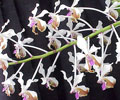|
|
|
|
|
| |
Flasks of
Vanda lamellata '#1' × self |
|
| |
|
|
| |
|
|
Click to Enlarge

Pod Parent Flowers |
|
|
|
| |
Culture Notes from Donor: Parent plant: Temperature range CI (58-75°F)
Comments: Parent plant: Large plant.
For additional origin/habitat information supplied courtesy of
Charles and Margaret Baker, see further below, near the bottom of this page.
|
Temperatures we attempt to use in the lab & greenhouse:
| For Species: |
|
Summer, Autumn: days average 85°F, nights 74°F; best fit is Warm 90-70°F
(Source:
Baker's Web OSC) |
| For Species: |
|
Spring: days average 90°F, nights 74°F; best fit is Warm 90-70°F
(Source:
Baker's Web OSC) |
| For Species: |
|
Winter: days average 86°F, nights 71°F; best fit is Warm 90-70°F
(Source:
Baker's Web OSC) |
|
About the name...
| Etymology of |
lamellata |
|
From Latin "lamellatus" with small lamina (thin sheets or blades).
(Sources:
Mayr & Schmucker 1998, Brown 1956) |
| Etymology of |
Vanda |
|
From Indian dialect "Vanda"; the name for orchids of the Vanda-like shape in the local Indian language.
(Source:
Mayr & Schmucker 1998) |
| Pronunciation of |
lamellata |
|
lam-el-AH-ta
(Source:
Hawkes 1978) |
| Pronunciation of |
Vanda |
|
VAN-da
(Source:
Hawkes 1978) |
|
If you would like to direct someone to this web page, please copy and paste this URL into your email:
http://troymeyers.com/d?014937
| Flask Information |
| Availability: |
Seed not viable- failed. We were not able to make any flasks. |
| You should: |
Consider placing a "Notify Retries" Request, and if an identical pollination (the same parents) is done again, we'll let you know. |
|
You might also want to:
|
View the seed assay for this item.
View items of the same species.
View items of the same genus.
|
| Ordering Information |
| You are not currently logged in. |
|
You must be a registered user and be logged in to reserve a flask or place a notification request. Please log in:
|
|
|
|
|
|
| |
The origin/habitat information below is supplied courtesy of Charles and Margaret Baker
The following information is based on the name of the plant provided by the donor, and assumes that the name is correct. If the plant has been misidentified, then the following information may not be correct.
This text is copyrighted by the Bakers and may not be reproduced without permission.
ORIGIN/HABITAT: The Philippines, Borneo, Taiwan, and the Mariana and
Ryukyu Islands. This sun-loving, epiphytic and lithophytic orchid is one
of the most common and hardy vandas found in the Philippines. It is found
in many provinces on Luzon Island, including Abra, Bataan, Batangas,
Benguet Cavite, Ifugao, Laguna, Quezon, and Rizal. Plants have also been
found on the islands of Panay, Mindoro, Palawan, and Sulu. Throughout the
Philippines, plants grow on both trees and rocks from near sea level up to
about 1300 ft. (400 m). In Borneo, plants are found in Sabah on Mantanani
Besar Island, Banggi Island, Tigabu Island, and in the Kudat District.
Plants grow on branches and trunks of trees in forest on limestone, in
coastal forests near the beach, and on sea-cliff scrub from near sea level
to about 350 ft. (100 m). Plants often are found in full sunlight and are
occasionally found in situations where they are exposed to salt spray
during storms. In Taiwan, this orchid is known only from Lanyu Island
(Botel Tobago), an island off the southeast coast of Taiwan where plants
usually are found on exposed rocks or tree trunks.
More about this information and the Bakers...
|
|
|
| |
|
|
|